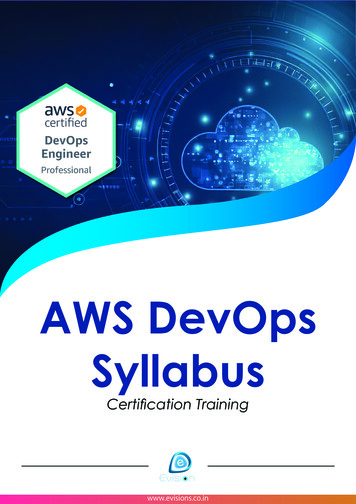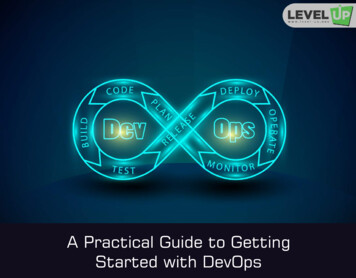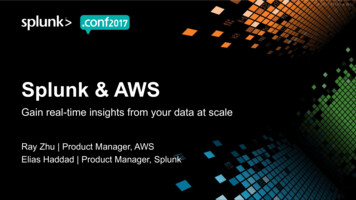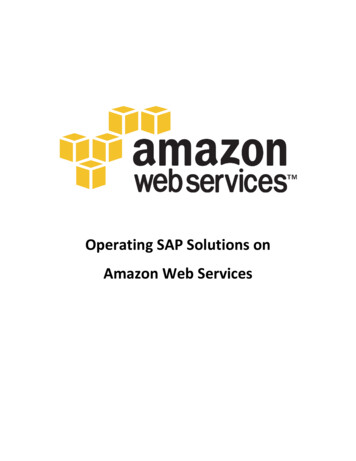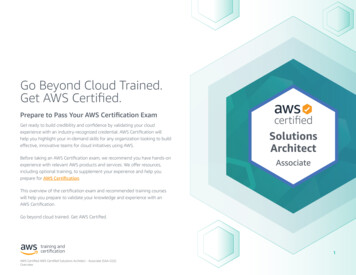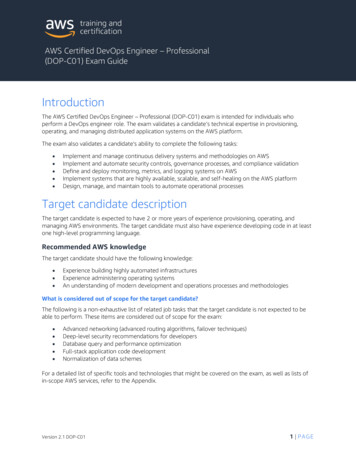
Transcription
AWS Certified DevOps Engineer – Professional(DOP-C01) Exam GuideIntroductionThe AWS Certified DevOps Engineer – Professional (DOP-C01) exam is intended for individuals whoperform a DevOps engineer role. The exam validates a candidate’s technical expertise in provisioning,operating, and managing distributed application systems on the AWS platform.The exam also validates a candidate’s ability to complete the following tasks: Implement and manage continuous delivery systems and methodologies on AWSImplement and automate security controls, governance processes, and compliance validationDefine and deploy monitoring, metrics, and logging systems on AWSImplement systems that are highly available, scalable, and self-healing on the AWS platformDesign, manage, and maintain tools to automate operational processesTarget candidate descriptionThe target candidate is expected to have 2 or more years of experience provisioning, operating, andmanaging AWS environments. The target candidate must also have experience developing code in at leastone high-level programming language.Recommended AWS knowledgeThe target candidate should have the following knowledge: Experience building highly automated infrastructuresExperience administering operating systemsAn understanding of modern development and operations processes and methodologiesWhat is considered out of scope for the target candidate?The following is a non-exhaustive list of related job tasks that the target candidate is not expected to beable to perform. These items are considered out of scope for the exam: Advanced networking (advanced routing algorithms, failover techniques)Deep-level security recommendations for developersDatabase query and performance optimizationFull-stack application code developmentNormalization of data schemesFor a detailed list of specific tools and technologies that might be covered on the exam, as well as lists ofin-scope AWS services, refer to the Appendix.Version 2.1 DOP-C011 PAG E
Exam contentResponse typesThere are two types of questions on the exam: Multiple choice: Has one correct response and three incorrect responses (distractors)Multiple response: Has two or more correct responses out of five or more response optionsSelect one or more responses that best complete the statement or answer the question. Distractors, orincorrect answers, are response options that a candidate with incomplete knowledge or skill might choose.Distractors are generally plausible responses that match the content area.Unanswered questions are scored as incorrect; there is no penalty for guessing. The exam includes65 questions that will affect your score.Unscored contentThe exam includes 10 unscored questions that do not affect your score. AWS collects information aboutcandidate performance on these unscored questions to evaluate these questions for future use as scoredquestions. These unscored questions are not identified on the exam.Exam resultsThe AWS Certified DevOps Engineer – Professional (DOP-C01) exam is a pass or fail exam. The exam isscored against a minimum standard established by AWS professionals who follow certification industrybest practices and guidelines.Your results for the exam are reported as a scaled score of 100–1,000. The minimum passing score is 750.Your score shows how you performed on the exam as a whole and whether or not you passed. Scaledscoring models help equate scores across multiple exam forms that might have slightly different difficultylevels.Your score report may contain a table of classifications of your performance at each section level. Thisinformation is intended to provide general feedback about your exam performance. The exam uses acompensatory scoring model, which means that you do not need to achieve a passing score in eachsection. You need to pass only the overall exam.Each section of the exam has a specific weighting, so some sections have more questions than othersections have. The table contains general information that highlights your strengths and weaknesses. Usecaution when interpreting section-level feedback.Content outlineThis exam guide includes weightings, test domains, and objectives for the exam. It is not a comprehensivelisting of the content on the exam. However, additional context for each of the objectives is available tohelp guide your preparation for the exam. The following table lists the main content domains and theirweightings. The table precedes the complete exam content outline, which includes the additional context.The percentage in each domain represents only scored content.Version 2.1 DOP-C012 PAG E
Domain% of ExamDomain 1: SDLC Automation22%Domain 2: Configuration Management and Infrastructure as Code19%Domain 3: Monitoring and Logging15%Domain 4: Policies and Standards Automation10%Domain 5: Incident and Event Response18%Domain 6: High Availability, Fault Tolerance, and Disaster Recover16%TOTAL100%Domain 1: SDLC Automation1.1 Apply concepts required to automate a CI/CD pipeline Set up repositories Set up build services Integrate automated testing (e.g., unit tests, integrity tests) Set up deployment products/services Orchestrate multiple pipeline stages1.2 Determine source control strategies and how to implement them Determine a workflow for integrating code changes from multiple contributors Assess security requirements and recommend code repository access design Reconcile running application versions to repository versions (tags) Differentiate different source control types1.3 Apply concepts required to automate and integrate testing Run integration tests as part of code merge process Run load/stress testing and benchmark applications at scale Measure application health based on application exit codes (robust Health Check) Automate unit tests to check pass/fail, code coverageo CodePipeline, CodeBuild, etc. Integrate tests with pipeline1.4 Apply concepts required to build and manage artifacts securely Distinguish storage options based on artifacts security classification Translate application requirements into Operating System and package configuration (buildspecs) Determine the code/environment dependencies and required resourceso Example: CodeDeploy AppSpec, CodeBuild buildspec Run a code build processVersion 2.1 DOP-C013 PAG E
1.5 Determine deployment/delivery strategies (e.g., A/B, Blue/green, Canary, Red/black) and how toimplement them using AWS services Determine the correct delivery strategy based on business needs Critique existing deployment strategies and suggest improvements Recommend DNS/routing strategies (e.g., Route 53, ELB, ALB, load balancer) based onbusiness continuity goals Verify deployment success/failure and automate rollbacksDomain 2: Configuration Management and Infrastructure as Code2.1 Determine deployment services based on deployment needs Demonstrate knowledge of process flows of deployment models Given a specific deployment model, classify and implement relevant AWS services to meetrequirementso Given the requirement to have DynamoDB choose CloudFormation instead ofOpsWorkso Determine what to do with rolling updates2.2 Determine application and infrastructure deployment models based on business needs Balance different considerations (cost, availability, time to recovery) based on businessrequirements to choose the best deployment model Determine a deployment model given specific AWS services Analyze risks associated with deployment models and relevant remedies2.3 Apply security concepts in the automation of resource provisioning Choose the best automation tool given requirements Demonstrate knowledge of security best practices for resource provisioning (e.g., encryptingdata bags, generating credentials on the fly) Review IAM policies and assess if sufficient but least privilege is granted for all lifecycle stagesof a deployment (e.g., create, update, promote) Review credential management solutions (e.g., EC2 parameter store, third party) Build the automationo CloudFormation template, Chef Recipe, Cookbooks, Code pipeline, etc.2.4 Determine how to implement lifecycle hooks on a deployment Determine appropriate integration techniques to meet project requirements Choose the appropriate hook solution (e.g., implement leader node selection after a nodefailure) in an Auto Scaling group Evaluate hook implementation for failure impacts (if a remote call fails, if a dependent serviceis temporarily unavailable (i.e., Amazon S3), and recommend resiliency improvements Evaluate deployment rollout procedures for failure impacts and evaluate rollback/recoveryprocesses2.5 Apply concepts required to manage systems using AWS configuration management tools andservices Identify pros and cons of AWS configuration management tools Demonstrate knowledge of configuration management components Show the ability to run configuration management services end to end with no assistancewhile adhering to industry best practicesVersion 2.1 DOP-C014 PAG E
Domain 3: Monitoring and Logging3.1 Determine how to set up the aggregation, storage, and analysis of logs and metrics Implement and configure distributed logs collection and processing (e.g., agents, syslog,flumed, CW agent) Aggregate logs (e.g., Amazon S3, CW Logs, intermediate systems (EMR), Kinesis FH –Transformation, ELK/BI) Implement custom CW metrics, Log subscription filters Manage Log storage lifecycle (e.g., CW to S3, S3 lifecycle, S3 events)3.2 Apply concepts required to automate monitoring and event management of an environment Parse logs (e.g., Amazon S3 data events/event logs/ELB/ALB/CF access logs) and correlatewith other alarms/events (e.g., CW events to AWS Lambda) and take appropriate action Use CloudTrail/VPC flow logs for detective control (e.g., CT, CW log filters, Athena, NACL orWAF rules) and take dependent actions (AWS step) based on error handling logic (statemachine) Configure and implement Patch/inventory/state management using ESM (SSM), Inspector,CodeDeploy, OpsWorks, and CW agentso EC2 retirement/maintenance Handle scaling/failover events (e.g., ASG, DB HA, route table/DNS update, Application Config,Auto Recovery, PH dashboard, TA) Determine how to automate the creation of monitoring3.3 Apply concepts required to audit, log, and monitor operating systems, infrastructures, andapplications Monitor end to end service metrics (DDB/S3) using available AWS tools (X-ray with EB andLambda) Verify environment/OS state through auditing (Inspector), Config rules, CloudTrail (processand action), and AWS APIs Enable, configure, and analyze custom metrics (e.g., Application metrics, memory, KCL/KPL)and take action Ensure container monitoring (e.g., task state, placement, logging, port mapping, LB) Distinguish between services that enable service level or OS level monitoringo Example: AWS services that use OS agents (e.g., Inspector, SSM)3.4 Determine how to implement tagging and other metadata strategies Segregate authority based on tagging (lifecycle stages – dev/prod) with Condition contextkeys Utilize Amazon S3 system/user-defined metadata for classification and automation Design and implement tag-based deployment groups with CodeDeploy Best practice for cost allocation/optimization with taggingDomain 4: Policies and Standards Automation4.1 Apply concepts required to enforce standards for logging, metrics, monitoring, testing, and security Detect, report, and respond to governance and security violations Apply logging standards across application, operating system, and infrastructure Apply context specific application health and performance monitoring Outline standards for delivery models for logs and metrics (e.g., JSON, XML, DataNormalization)Version 2.1 DOP-C015 PAG E
4.2 Determine how to optimize cost through automation Prioritize automation effort to reduce labor costs Implement right sizing of workload based on metrics Assess ways to improve time to market through automating process orchestration andrepeatable tasks Diagnose outliers to determine use case fito Example: Configuration drift Measure and automate cost optimization through eventso Example: Trusted Advisor4.3 Apply concepts required to implement governance strategies Generalize governance standards across CI/CD pipeline Outline and measure the real-time status of compliance with governance strategies Report on compliance with governance strategies Deploy governance policies related to self-service capabilitieso Example: Service Catalog, CFN NagDomain 5: Incident and Event Response5.1 Troubleshoot issues and determine how to restore operations Given an issue, evaluate how to narrow down the unhealthy components as quickly as possible Given an increase in load, determine what steps to take to mitigate the impact Determine the causes and impacts of a failureo Example: Deployment, operations Determine the best way to restore operations after a failure occurs Investigate and correlate logged events with application componentso Example: application source code5.2 Determine how to automate event management and alerting Set up automated restores from backup in the event of a catastrophic failure Set up methods to deliver alerts and notifications that are appropriate for different types ofevents Assess the quality/actionability of alerts Configure metrics appropriate to an application’s SLAs Proactively update limits5.3 Apply concepts required to implement automated healing Set up the correct scaling strategy to enable auto-healing when a failure occurs (e.g., withAuto Scaling policies) Use the correct rollback strategy to avoid impact from failed deployments Configure Route 53 to ensure cross-Region failover Detect and respond to maintenance or Spot termination events5.4 Apply concepts required to set up event-driven automated actions Configure Lambda functions or CloudWatch actions to implement automated actions Set up CloudWatch event rules and/or Config rules and targets Use AWS Systems Manager or Step Functions to coordinate components (e.g., Lambda, usemaintenance windows) Configure a build/roll-out process to automatically respond to critical software updatesVersion 2.1 DOP-C016 PAG E
Domain 6: High Availability, Fault Tolerance, and Disaster Recovery6.1 Determine appropriate use of multi-AZ versus multi-Region architectures Determine deployment strategy based on HA/DR requirements Determine data replication strategy based on cost and durability requirements Determine infrastructure, platform, and services based on HA/DR requirements Design for HA/FT/DR based on service availability (i.e., global/regional/single AZ)6.2 Determine how to implement high availability, scalability, and fault tolerance Design deployment strategy to support HA/FT/scalability Assess statefulness of application infrastructure components Use load balancing to distribute traffic across multiple AZ/ASGs/instance types (spot/M4 vsC4) /targets Use appropriate caching solutions to improve availability and performance6.3 Determine the right services based on business needs (e.g., RTO/RPO, cost) Determine cost-effective storage solution for your applicationo Example: tiered, archival, EBS type, hot/cold Choose a database platform and configuration to meet business requirements Choose a cost-effective compute platform based on business requirementso Example: Spot Choose a deployment service/model based on business requirementso Example: Code Deploy, Blue/Green deployment Determine when to use managed service vs. self-managed infrastructure (Docker on EC2 vs.ECS)6.4 Determine how to design and automate disaster recovery strategies Automate failure detection Automate components/environment recovery Choose appropriate deployment strategy for environment recovery Design automation to support failover in hybrid environment6.5 Evaluate a deployment for points of failure Determine appropriate deployment-specific health checks Implement failure detection during deployment Implement failure event handling/response Ensure that resources/components/processes exist to react to failures during deployment Look for exit codes on each event of the deployment Map errors to different points of deploymentVersion 2.1 DOP-C017 PAG E
AppendixWhich key tools, technologies, and concepts might be covered on the exam?The following is a non-exhaustive list of the tools and technologies that could appear on the exam. This listis subject to change and is provided to help you understand the general scope of services, features, ortechnologies on the exam. The general tools and technologies in this list appear in no particular order.AWS services are grouped according to their primary functions. While some of these technologies will likelybe covered more than others on the exam, the order and placement of them in this list is no indication ofrelative weight or importance: Application deploymentApplication integrationApplication pipelinesAutomationCode repository best practicesCost optimizationDeployment requirementsHybrid deploymentsIAM policiesMetrics, monitoring, alarms, and loggingNetwork ACL and security group design and implementationOperational best practicesRollback proceduresAWS services and featuresAnalytics: Amazon AthenaAmazon EMRAmazon Kinesis Data FirehoseAmazon Kinesis Data StreamsAmazon QuickSightCompute: Amazon EC2Amazon EC2 Auto ScalingContainers: AWS App RunnerAmazon Elastic Container Registry (Amazon ECR)Amazon Elastic Container Service (Amazon ECS)Amazon Elastic Kubernetes Service (Amazon EKS)AWS FargateDatabase: Amazon DynamoDBAmazon RDSAmazon RedshiftVersion 2.1 DOP-C018 PAG E
Developer Tools: AWS Cloud Development Kit (AWS CDK)AWS CloudShellAWS CodeArtifactAWS CodeBuildAWS CodeCommitAWS CodeDeployAmazon CodeGuruAWS CodePipelineAWS CodeStarAWS Command Line Interface (CLI)AWS X-RayManagement and Governance: AWS CloudFormation AWS CloudTrail Amazon CloudWatch AWS Config AWS OpsWorks AWS Organizations AWS Systems Manager AWS Trusted AdvisorNetworking and Content Delivery: Amazon API Gateway AWS Client VPN Amazon CloudFront Amazon Route 53 AWS Site-to-Site VPN AWS Transit Gateway Amazon VPC Elastic Load BalancingSecurity, Identity, and Compliance: Amazon GuardDuty AWS Identity and Access Management (IAM) Amazon Inspector AWS Key Management Service (AWS KMS) AWS Secrets Manager AWS Single Sign-On AWS WAFServerless: Amazon EventBridge (Amazon CloudWatch Events)AWS LambdaAWS Serverless Application Model (AWS SAM)Amazon Simple Notification Service (Amazon SNS)Amazon Simple Queue Service (Amazon SQS)AWS Step FunctionsVersion 2.1 DOP-C019 PAG E
Storage: Amazon Elastic Block Store (Amazon EBS)Amazon Elastic File System (Amazon EFS)Amazon S3AWS Storage GatewayVersion 2.1 DOP-C0110 PAG E
Exam results The AWS Certified DevOps Engineer - Professional (DOP-C01) exam is a pass or fail exam. The exam is scored against a minimum standard established by AWS professionals who follow certification industry best practices and guidelines. Your results for the exam are reported as a scaled score of 100-1,000. The minimum passing score .

